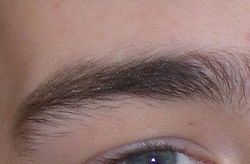синкым
Hello, you have come here looking for the meaning of the word синкым. In DICTIOUS you will not only get to know all the dictionary meanings for the word синкым, but we will also tell you about its etymology, its characteristics and you will know how to say синкым in singular and plural. Everything you need to know about the word синкым you have here. The definition of the word синкым will help you to be more precise and correct when speaking or writing your texts. Knowing the definition ofсинкым, as well as those of other words, enriches your vocabulary and provides you with more and better linguistic resources.

Синкым.
Komi-Zyrian

Etymology
From Proto-Permic *śinku̇m, equivalent to син (śin, “eye”) + *кым (*kym, “corner”). The latter is not attested on its own in Komi, but is related to Finnish kulma. Cognate with Komi-Permyak синкым (śinkym).
Pronunciation
Noun
синкым • (śinkym)
Declension
| singular | plural | ||
|---|---|---|---|
| nominative | синкым (śinkym) | синкымъяс (śinkymjas) | |
| accusative | I 1 | синкым (śinkym) | синкымъяс (śinkymjas) |
| II 1 | синкымӧс (śinkymös) | синкымъясӧс (śinkymjasös) | |
| instrumental | синкымӧн (śinkymön) | синкымъясӧн (śinkymjasön) | |
| comitative | синкымкӧд (śinkymköd) | синкымъяскӧд (śinkymjasköd) | |
| caritive | синкымтӧг (śinkymtög) | синкымъястӧг (śinkymjastög) | |
| consecutive | синкымла (śinkymla) | синкымъясла (śinkymjasla) | |
| genitive | синкымлӧн (śinkymlön) | синкымъяслӧн (śinkymjaslön) | |
| ablative | синкымлысь (śinkymlyś) | синкымъяслысь (śinkymjaslyś) | |
| dative | синкымлы (śinkymly) | синкымъяслы (śinkymjasly) | |
| inessive | синкымын (śinkymyn) | синкымъясын (śinkymjasyn) | |
| elative | синкымысь (śinkymyś) | синкымъясысь (śinkymjasyś) | |
| illative | синкымӧ (śinkymö) | синкымъясӧ (śinkymjasö) | |
| egressive | синкымсянь (śinkymśań) | синкымъяссянь (śinkymjasśań) | |
| approximative | синкымлань (śinkymlań) | синкымъяслань (śinkymjaslań) | |
| terminative | синкымӧдз (śinkymödź) | синкымъясӧдз (śinkymjasödź) | |
| prolative | I | синкымӧд (śinkymöd) | синкымъясӧд (śinkymjasöd) |
| II | синкымті (śinkymti) | синкымъясті (śinkymjasti) | |
1 Animate nouns almost exclusively take the type II accusative ending, whereas inanimate nouns can be used with either ending, but are more often found with type I.
1 Animate nouns almost exclusively take the type II accusative ending, whereas inanimate nouns can be used with either ending, but are more often found with type I.
1 Animate nouns almost exclusively take the type II accusative ending, whereas inanimate nouns can be used with either ending, but are more often found with type I.
1 Animate nouns almost exclusively take the type II accusative ending, whereas inanimate nouns can be used with either ending, but are more often found with type I.
1 Animate nouns almost exclusively take the type II accusative ending, whereas inanimate nouns can be used with either ending, but are more often found with type I.
1 Animate nouns almost exclusively take the type II accusative ending, whereas inanimate nouns can be used with either ending, but are more often found with type I.
1 Animate nouns almost exclusively take the type II accusative ending, whereas inanimate nouns can be used with either ending, but are more often found with type I.
| ||||||||||||||||||||||||||||||||||||||||||||||||||||||||||||||||||||||||||||||||||||||||||||||||||||||||||||||||||||||||||||||||||||||||||||||||||||||||||||||||||||||||||||||||||||||||||||||||||||||||||||||||||||||||||||||||||||||||||||||||||||||||||||||||||||||||||||||||||||||||||||||||||||||||||||||||||||||||||||||||||||||||||||||||||||||||||||||||||||||||||||||||||||||||||||||||||||||||||||||||||||||||||||||||||||||||||||||||||||||||||||
Related terms
- кымӧс (kymös, “forehead”)
References
- A. I. Podorova, editor (1948), Коми-русский словарь , Syktyvkar: Коми Государственное Издательство, page 106
- L. M. Beznosikova, E. A. Ajbabina, R. I. Kosnyreva (2000) Коми-русский словарь , →ISBN, page 588